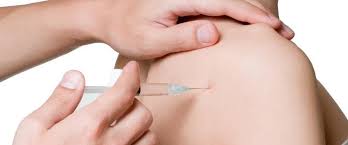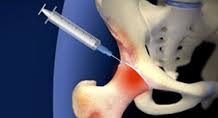Ozone Gas Injections may do the Trick for Knee Osteoarthritis .
Introduction
Ozone is a highly soluble gas with great oxidiz-
ing activity. In contact with biological fluids ozone
forms lipid oxidation products and reactive oxygen
species.

These substances react with white blood
cells triggering the production of cytokines, pro-
teins strongly conditioning inflammatory reactions,
and red blood cells enhancing the oxygen supply
to tissues.
Ozone is used to treat many painful syndromes
affecting the joints, muscles and tendons even when
peripheral neurological impairment is present.
Its painkilling mechanism is thought to be based
on stimulation of the antinociceptive apparatus
mediated by endogenous opioids and serotonin
thereby raising the pain threshold. In addition, the
marked anti-inflammatory properties of ozone
reduce oedema, joint swelling and compression on
nerve root structures.
Ozone favours tissue hyper-
oxygenation following increased vascularization
due to neoangiogenesis
improving local tissue
trophism and the inhibitory capacity of inflamma-
tory metabolites.
There is a consensus in literature reports that
the sum of the beneficial effects of ozone reduces
local pain favouring the recovery of joint function
and motion lost during the painful phase (walk-
ing, going up and down staires, washing, dressing
and feeding). Ozone injections (intra-articular,
peri-articular or percutaneous) are considered a
Oxygen-Ozone Treatment of the Knee,
Shoulder and Hip.
Administration and Dose
After thorough examination of the patient and
obtaining signed informed consent to oxygen-
ozone injection, the gas mixture is administered.
Ordinary sterile conditions are maintained for dis-
infection of the patient’s skin as well as the syringe,
needles and hands. The increasing use of oxygen-
ozone injections to treat inflammatory-degenera-
tive diseases of the joints has led to a specific treat-
ment protocol defining the gas concentrations,
doses and infiltration techniques to follow. Some
authors favour a single intra-articular injection
with or without instrumental guidance. Others pre-
fer the peri-articular approach with injection into
certain standardized painful points for each district.
Experience has shown that there is no single
effective dose for all patients: the ozone probably
needs to reach an activation threshold to exert its
potent pharmacological effects. The latest indica-
tions of the Italian Federation of Oxygen-Ozone
Therapy clearly recommend smaller amounts of
gas
than in the past with slightly higher concentra-
tions of ozone. The gas mixture should be inject-
ed slowly, always after aspiration. The protocol
includes an initial cycle of at least 3-5 injections
Oxygen-Ozone Treatment of the Knee, Shoulder and Hip.
at weekly intervals. The infiltration is usually pain-
less. The route of administration and ozone dose
are reported in clinical cases for each of the main
joints treated.
Knee

Oxygen-ozone therapy is used to treat patients
with gonarthosis (initial and late), inflammatory
disease due to overloading, patellar tendinitis,
goosefoot bursitis of the knee, synovitis during
inflammatory arthritis, bursitis, knee pain caused
by joint cartilage degeneration due to femoral-rot-
ular chondropathy, knee pain following surgery.
The patient is placed in a supine position with the
knee in extension. After having located the patella
its medial margin is pressed to subluxation in the
lateral margin to increase the articular rim as much
as possible. A 21G needle is inserted along the
superolateral margin of the patella (to the superior
third). After thorough sepsis and aspiration, 10-15
cc of the gas mixture is injected slowly at variable
concentrations depending on the disease and in
any case not more than 25 μg/ml. The patient is
invited to perform some flexion-extension move-
ments of the knee to better distribute the drug
throughout the joint including the recesses.
Shoulder

Oxygen-ozone therapy is used to treat patients
with inflammatory rotator cuff tendinopathy (also
due to overloading), tendinitis of the supraspinatus
muscle caused by impingement, tenosynovitis of
the long head of the biceps, subacromial bursitis,
frozen shoulder, pain following surgery, painful
shoulder in the course of inveterate rupture of the
cuff.
Oxygen-ozone is injected into the shoulder via
the posterior approach, laterally under the inferior
margin of the acromion using a 22G needle. After
aspiration and thorough asepsis up to 10cc of oxy-
gen-ozone mixture are injected slowly at varying
concentrations depending on the condition but not
more than 25 μg/ml. If clinically indicated, it is also
useful to puncture the subacromial bursa and the
stretch of the long head of the biceps muscle with a
27G needle injecting microdoses of 0.5-1 cc.
Whenever possible oxygen-ozone therapy should
be flanked by a period of rehabilitation with indi-
vidually prescribed exercises.
Hip

Oxygen-ozone therapy is used to treat hip pain
due to functional overload, pain caused by cox-
arthrosis (initial and late), trochanteric bursitis,
hip tendonitis and pain following hip surgery.
Whenever possible oxygen-ozone therapy should
be flanked by a period of rehabilitation with indi-
vidually prescribed exercises.
The lateral approach is indicated in oxygen-
ozone therapy of the hip. After having located the
cranial margin of the greater trochanter and after
sterilizing the area a 25G needle is inserted in a
direction perpendicular to the greater trochanter
and after aspiration slowly injecting 5 cc of an oxy-
gen-ozone mixture at a concentration of 25 μg/ml.